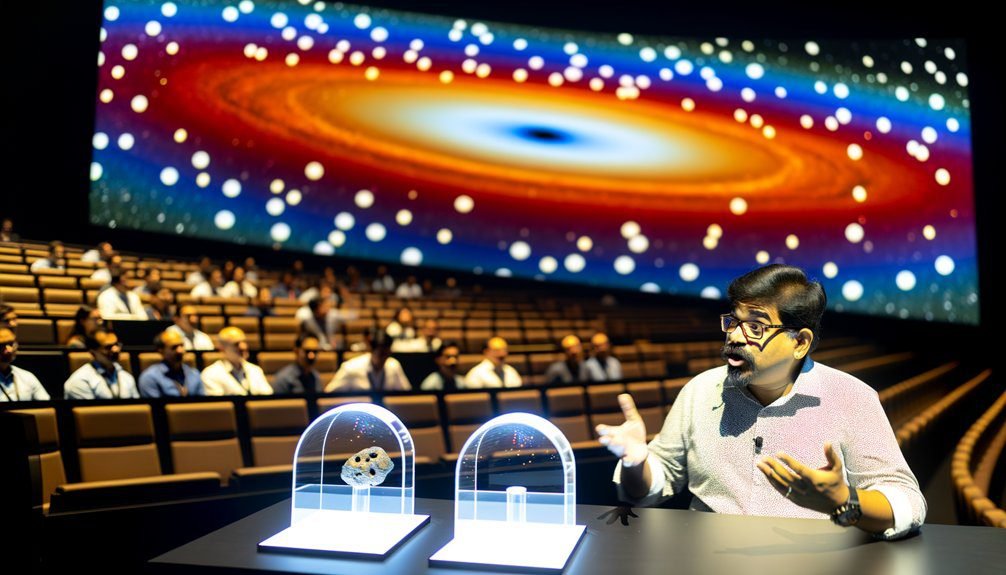You should be clear, open, and empathetic: explain evidence and uncertainty in plain language, publish data and methods, and show how you measured confidence so people can judge for themselves. Host interactive events, partner with educators and trusted spokespeople, and provide mental-health and cultural support. Work with media using embargoed briefings and accessible visuals to prevent sensationalism. Lay out verification steps and timelines so everyone knows what comes next, and keep engaging for deeper guidance.
Key Takeaways
- Lead with a clear headline takeaway, one-paragraph plain-language explanation, and an example to make the discovery understandable.
- Publish methods, raw data, and analysis code openly, with readme files to enable verification and trust.
- Explain detection criteria and confidence metrics simply, and describe practical implications and uncertainties for nonexperts.
- Engage communities through forums, workshops, and co-designed materials, ensuring cultural sensitivity and equitable access to information.
- Coordinate transparent media briefings, trusted spokespeople, and mental-health resources to prevent misinformation and manage public reaction.
Communicating Detection Criteria and Confidence Levels

When you announce a possible extraterrestrial detection, be explicit about the criteria used and the degree of confidence behind the claim so people can judge its meaning and limits. You’ll want to outline clear detection criteria: what signals, patterns, or corroborating observations qualify as significant, and which potential sources or errors were ruled out. State the confidence metrics you’re using — statistical significance, false-alarm probability, replication count — and explain their practical implications so nonexperts grasp how decisive the evidence is. Be honest about uncertainties, thresholds, and instrument limitations; that builds credibility. Provide a concise timeline for verification steps and who’s responsible, so the public sees the process not as mysterious but as rigorous. Avoid jargon without dumbing down the science: precise terms paired with brief definitions let readers judge for themselves. Done right, this approach reduces speculation, anchors expectations, and fosters informed public engagement.
Translating Technical Findings Into Plain Language
Because technical results are only useful if people can understand their meaning, you should translate findings into plain language that keeps the facts intact while cutting jargon, numbers, and caveats down to their essentials. Focus on simplifying terminology: replace specialized acronyms with short, clear phrases and define unavoidable terms in one sentence. Prioritize the core claim, why it matters, and what evidence supports it, then show limits without drowning readers in probabilities or footnotes.
Use analogies to make unfamiliar concepts relatable — compare signal strength to a distant flashlight or molecular signatures to a fingerprint — but don’t let metaphors overpromise. Structure messages for quick scanning: headline takeaway, one-paragraph explanation, and a short example. Invite questions and point to one clear next step for curious readers. By keeping language precise, accessible, and honest, you’ll help the public grasp discoveries without losing scientific integrity.
Building Trust Through Transparency and Open Data

If you want the public to take extraterrestrial discoveries seriously, transparency and open data are nonnegotiable: share methods, raw data, and analysis tools in ways that people — from journalists to independent researchers — can inspect and reproduce. You’ll build credibility by prioritizing data accessibility: provide clear documentation, machine-readable files, and versioned repositories so anyone can verify claims. Use trust building strategies like timely updates and honest discussion of uncertainties; admitting limits increases authority, not reduces it.
Transparency and open data are essential: share methods, raw data, and code so anyone can inspect and reproduce findings.
- Release raw datasets with explanatory readme files to invite scrutiny and collaboration.
- Publish analysis code and workflows so results can be reproduced step-by-step.
- Offer clear provenance and metadata to show how data were collected and processed.
- Communicate uncertainties and correction processes to demonstrate accountability.
When you make openness routine, you cultivate a scientific ecosystem where the public feels invited, informed, and confident that findings are trustworthy rather than opaque or curated.
Engaging Communities With Interactive Public Events
Although complex discoveries can feel distant, interactive public events bring them into your community’s hands and minds by turning passive information into active experience. You’ll use interactive workshops to demonstrate instruments, simulate data analysis, and let people test hypotheses, which builds understanding and demystifies methods. Design activities for different ages and backgrounds, with clear goals and takeaways so attendees leave informed, not overwhelmed. Host community forums that invite questions, surface concerns, and gather local perspectives; treat them as listening sessions as much as presentations. Recruit subject-matter facilitators who explain uncertainty candidly and model how science updates with new evidence. Provide accessible materials, translation, and varied formats—hands-on tables, short talks, and Q&A circles—to reach more people. Track attendance, feedback, and learning outcomes to refine future events. By centering interaction, transparency, and mutual respect, you’ll create durable public engagement that turns curiosity into informed dialogue and strengthens collective capacity to respond thoughtfully to extraterrestrial discoveries.
Collaborating With Media for Accurate Coverage

When news of an extraterrestrial discovery breaks, you’ll want journalists and outlets to report it accurately and responsibly—so build relationships with media before crises occur. You should cultivate media partnerships that emphasize transparency, provide accessible briefings, and offer expert sources who can explain methods and limits. Clear, regular contact reduces speculation and supports accurate reporting.
- Share verified facts promptly to prevent rumor and calm public concern.
- Offer embargoed briefings so reporters can prepare thoughtful coverage, not sensational headlines.
- Provide clear visuals and plain-language summaries to help journalists convey complex science.
- Establish a trusted spokespeople roster to guarantee consistent messages and credibility.
Preparing Clear Response Protocols and Timelines
Because timely, predictable actions reduce confusion and build trust, you should have documented response protocols and public timelines ready before any extraterrestrial announcement. You’ll define roles, decision points, and communication channels so everyone knows who speaks, when, and with what authority. Prioritize response readiness by creating checklists for evidence verification, stakeholder notification, and media briefings. Establish clear escalation criteria and backup plans to keep operations steady under uncertainty.
For timeline establishment, publish an initial cadence: immediate confirmation window, detailed analysis phase, and periodic public updates. Be explicit about probable durations and what each update will cover, and commit to revising timelines transparently if new data alters expectations. Use plain language, avoid jargon, and set expectations about what you can and can’t yet know. By aligning internal workflows with public timelines, you’ll reduce speculation, manage anxiety, and maintain credibility while complex scientific work proceeds.
Partnering With Educators to Integrate Discoveries Into Curricula

If you want discoveries about extraterrestrial life or technology to have lasting educational impact, partner early with teachers and curriculum developers so new findings are translated into age-appropriate lessons and inquiry activities. You’ll make certain curriculum development aligns with standards, scaffolds complex concepts, and builds curiosity rather than confusion. Offer ready-made modules, primary-source materials, and assessment rubrics teachers can adapt.
Work with schools to provide practical teacher training that models classroom strategies, safety protocols for speculative content, and ways to handle student questions. Fund pilot programs, collect feedback, and iterate quickly so resources stay accurate and classroom-ready.
- Excitement — give teachers tools that let students feel wonder without overwhelm.
- Confidence — guarantee teacher training demystifies content and boosts preparedness.
- Relevance — tie discoveries to real-world science and skills students will use.
- Trust — transparent collaboration with educators builds public confidence in how findings are taught.
Addressing Ethical, Cultural, and Psychological Concerns
Partnering with educators lays groundwork for how society learns about extraterrestrial findings, but you also need to confront the ethical, cultural, and psychological dimensions that follow public exposure. You should assess ethical implications early, setting transparent policies on data use, consent for participation in studies, and equitable access to information. Address cultural sensitivity by engaging diverse communities and respecting belief systems; invite leaders and scholars to co-design messaging so discoveries don’t marginalize traditions. Anticipate psychological impact by providing clear, calm explanations and mental health resources; train spokespeople to avoid sensationalism and to normalize varied emotional reactions. Monitor societal response through surveys and media analysis to detect misinformation, fear, or stigma, and adjust communication strategies accordingly. You’ll build public trust by showing accountability, inclusivity, and preparedness. Thoughtful planning across ethics, culture, and psychology will help you guide a measured, humane conversation about extraterrestrial discoveries.
Frequently Asked Questions
Will Governments Conceal Extraterrestrial Discoveries From the Public?
Governments might, but they won’t universally conceal extraterrestrial discoveries; motives vary. You’ll see cases where government transparency is prioritized to preserve public trust, while others may restrict information for security or political reasons. You’ve got to expect mixed approaches: some officials will share responsibly, others’ll withhold details. Advocating clear policies, independent oversight, and open scientific dialogue helps guarantee transparency and rebuilds public trust when surprises emerge.
How Soon Could Everyday Technology Be Affected by an Extraterrestrial Find?
Within years to decades, everyday technology could shift once alien technology is verified, though initial effects might be indirect. You’d see societal impact first in advanced sectors—communications, materials, energy—then trickle down into consumer devices as companies commercialize innovations. Adoption speed depends on verification, regulatory approval, and infrastructure. Expect cautious integration: some gadgets improving rapidly, others needing long safety and ethical vetting before reaching mainstream users.
Could Extraterrestrial Contact Bring New Diseases or Biological Risks?
Like a sudden storm, yes — extraterrestrial contact could introduce alien pathogens, though risk is speculative. You’d need strict biological containment and quarantine protocols to prevent accidental exposure. Scientists would screen samples, use high-level labs, and run controlled studies before any interaction. You’ll want transparent communication about risks and precautions, and international coordination to set containment standards, so public safety and scientific exploration proceed responsibly and confidently.
Who Decides if a Discovery Is Shared Internationally or Kept Local?
You and responsible authorities decide together: scientific teams follow discovery protocols, national agencies assess risks, and governments consult international treaties before sharing findings. Scientific advisory panels, biosecurity experts, and global bodies like the UN or COSPAR can recommend international disclosure. Ultimately elected officials authorize release, balancing transparency, safety, and diplomatic obligations. You’ll see coordinated steps—risk assessment, peer review, and treaty-guided consultation—before a local finding becomes an international announcement.
Will Private Companies Profit Exclusively From Extraterrestrial Materials?
No, private companies won’t necessarily profit exclusively from extraterrestrial materials. You’ll see varied arrangements—contracts, regulations, and partnerships—that influence profit margins and resource allocation. Governments and international bodies can impose rules, share royalties, or require public access to certain findings. You’ll be affected by licensing, taxes, and collaborative research that redistribute benefits. Expect a mixed landscape where private gain is balanced against public interest, oversight, and strategic resource management.